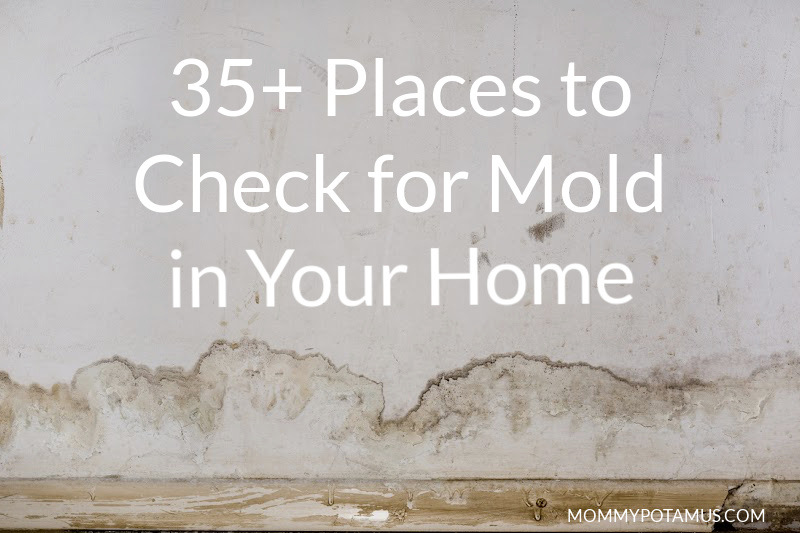
On the morning I woke up at 3am with water pouring through a light fixture onto my face, I tossed every sheet, towel and piece of clothing I could find onto the floor to try to mop things up while trying to figure out who to call for help. By 5am, a water restoration team was standing at my door.
I offered them coffee and thanked them for coming so early . . . and then I pulled out my phone and scrolled back to the photos from 2018. It was the year my family was exposed to stachybotrys chartarum (often called black mold) during an extended stay in a condo while we were relocating to a new state, and I’d documented our journey to recover from that exposure.
Most symptoms of mold illness are invisible, but not all. With my phone in hand I began to show them parts of our journey, like the time one of my sons developed a hematoma after a very mild injury because mold exposure impaired his ability to make a clotting protein called Factor VIII. We worked with a functional medicine MD to detox the mold and his clotting ability is perfectly normal now, but I wanted to make the health effects of mold exposure tangible for them.
I did my best to communicate what the stakes were, because I wasn’t just asking them to help me dry things out on a surface level. Instead, I wanted them to help me identify every single way this flood could create a mold problem and then help me prevent it.
They did, and when I had professional mold inspectors test my indoor air quality a year later, it was BETTER than samples we took as our baseline when the flood first happened.
It wasn’t perfect, though. We had some minor growth in common spots I hadn’t thought to check, which brings me to the most important lesson I learned through this process: Regularly inspecting common places that mold likes to grow can help find and address problems early.
According to one expert I spoke with, the major benefit of spring cleaning is that homeowners (and renters) often find issues that would otherwise be missed – leaks under sinks, damaged sealing near a toilet, etc.
In this article I’m going to share the key areas that my inspectors checked. I’m not an expert and this is not an exhaustive checklist of all the places mold can grow, but I hope it’s a helpful starting point. I’ll also be passing along advice they shared for maintaining a healthy indoor environment, plus additional tips I’ve picked up along the way.
What causes mold to grow in homes?
Almost every U.S. home has at least a little mold, but roughly 47% of homes have more substantial mold or dampness” – William Fisk, a senior scientist at Lawrence Berkeley National Laboratory who has researched mold for more than 10 years (1)
In nature, mold plays a vital role in breaking down “organic matter such as fallen leaves, dead trees and other debris.” (2) It can thrive pretty much anywhere there’s oxygen, moisture, and something to eat.
The thing about mold is that it’s not really picky – it will consume the log rotting by a riverbank, but it will also eat wood, drywall, paper, carpet, dust, paint, upholstery and more. (3) Mold replicates by releasing spores that circulate in the air.
They “can enter your home through open doorways, windows, vents, and heating and air conditioning systems. Mold in the air outside can also attach itself to clothing, shoes, and pets can and be carried indoors.” (3)
Sometimes the spores settle on a warm, moist surface and start replicating right away, but sometimes they land and remain dormant until they’re activated by moisture – a water leak, for example.
When mold grows in an enclosed environment like a home or office, it can impact human (and pet) health by releasing:
- Mold spores that can contribute to respiratory problems including asthma and allergic reactions affecting the lungs and sinuses
- Toxic byproducts called mycotoxins and microbial volatile organic compounds (MVOCs). These toxins can concentrate in the environment and are the driving factor behind “sick building syndrome,” aka mold illness.
What are the health effects of mold exposure?
According to Ann Shippy, MD, author of the Mold Toxicity Workbook, “mold toxicity causes different symptoms in different people and in different time frames.” Also, different mold toxins can have different effects. Some tend to be more neurotoxic (toxic to the nervous system), while others are more hepatotoxic (toxic to the liver) and so on.
In general, though, mold toxins are known to suppress immune function, trigger autoimmunity, disrupt and/or damage the nervous system, impair mitochondrial function, kill cells, damage organs like the liver and kidneys, act as carcinogens and more. (4) (5)
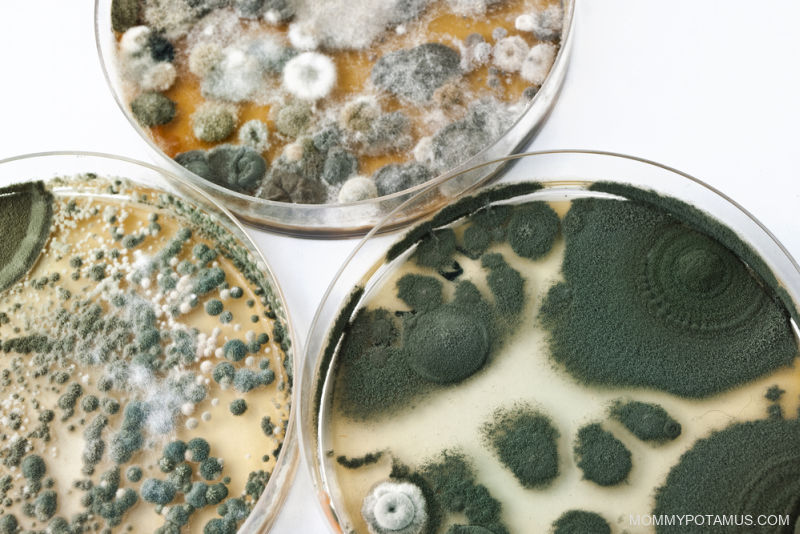
Common Types of Mold Found In Homes
You’ve probably heard mentions of “toxic black mold,” but not all mold that’s toxic is black and not all black mold is especially toxic (though significant growth of any mold can negatively impact indoor air quality). Mold comes in many colors – blue, yellow, orange, pink, green, grayish, black, brown and more – which is important to be aware of when you’re looking for it.
The three most common families of mold that you’ll find in indoor and outdoor environments are Aspergillus, Penicillium, and Cladosporium.(6) Within these families there are hundreds of species, some of which pose health risks and some which are pretty harmless. Let’s take a look at them, plus a few others that are pretty common.
Aspergillus
Often used in food fermentation (think soy sauce, miso and sake) and to make ascorbic acid (synthetic vitamin C), spores from the aspergillus family are very commonly found in homes, including mine. They’re carried in through the air when we open doors and windows, and via our HVAC unit.
According to the industrial hygienist that tested my indoor air quality right after our house flood, a few spores are not generally an issue. Problems can occur with aspergillus is able to begin growing indoors, where it can release mycotoxins including Aflatoxin M1, Aflatoxin B1, Aflatoxin B2, Aflatoxin G1, Aflatoxin G2, Ochratoxin A, Sterigmatocystin, Gliotoxin, Mycophenolic Acid, Dihydrocitrinone.
Aflatoxins are known carcinogens, and gliotoxin is associate with immune suppression. (7)(8)
Some species of aspergillus are opportunistic pathogens, meaning they can infect immune-compromised individuals. (9) In other words, in some cases aspergillus that is growing in the environment can also colonize the lungs and other organs of individuals.
Penicillium
Like aspergillus, some members of this family can be very useful. For example, Penicillium chrysogenum and Penicillium griseofulvum are used to make penicillin. It also produces some of the same mycotoxins as aspergillus – Ochratoxin A, Sterigmatocystin, Mycophenolic Acid and Dihydrocitrinone – plus others like Citrinin and Patulin.
Like aspergillus, some species of penicillium are opportunistic pathogens. (10)
Cladosporium
Many sources say that this family does not produce any known toxins, but can still cause allergic reaction due to the presence of hyphal fragments. (11) However, it does produce MVOCs that smell terrible, and some research suggests that it can produce mycotoxins under certain conditions. (12)
Stachybotrys
Often called “toxic black mold,” this is the family that usually needs no introduction. One species in particular – Stachybotrys chartarum – has been called “one of the world’s 10 most hazardous fungi” by researchers. (13)
Stachybotrys chartarum produces trichothecene mycotoxins including T-2, which “is believed to be at least 100 times more potent than either mustard gas or lewisite.” (14)
There is one piece of good news about this family: Although it produces T-2 and other mycotoxins such as Satratoxin G, Satratoxin H, Isosatratoxin F, Roridin A, Roridin H, Roridin L-2, Verrucarin A, Verrucarin J, and Roridin E, it does not appear to be able to live in the lungs or other organs of humans. In other words, it can grow around us, but not in us. (15)
Fusarium
As you might expect from a mold that creates a byproduct called Vomitoxin, fusarium can be found in grains (barley, wheat, maize, etc.) and water damaged buildings.
Fusarium also produces T-2 toxin, plus Zearalenone, Enniatin B1, Fumonisins B1, Fumonisins B2, Fumonisins B3, Roridin E, Verrucarin A, Nivalenol, and Diacetoxyscirpenol. It’s also an opportunistic pathogen. (16)
Other Common Molds That Can Be Found In Buildings
- Alternaria
- Mucor
- Chaetomium
- Trichoderma
- Ulocladium
- Aureobasidium
- Acremonium
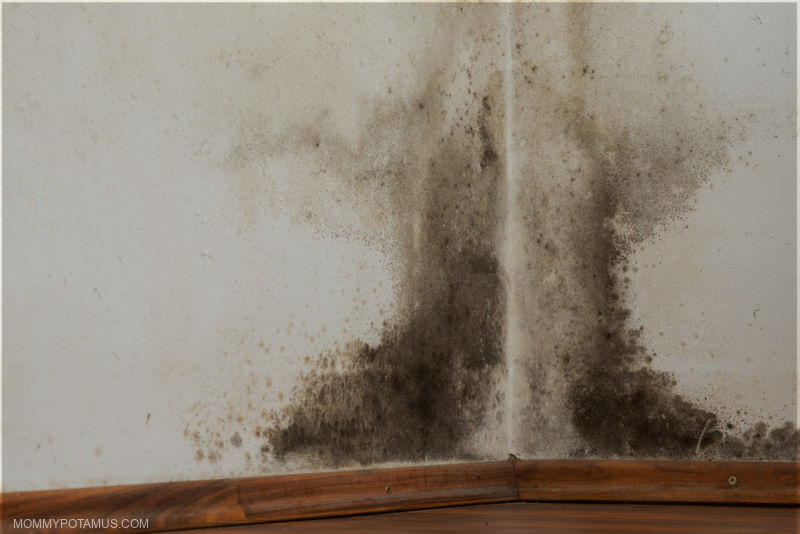
35+ Places to Check for Mold In Your Home
Here’s the checklist I created for my home after following my mold inspectors around:
Bathroom
If you’re like me, you love a nourishing coconut milk bath soak or hot shower. Unfortunately, because these surfaces tend to remain damp for long periods, it can create a warm/humid environment that attracts mold growth.
Here are some common areas to check:
- Shower and tub – Do you see any mold/mildew on grout, caulked areas, the shower curtain, etc? (Yep, mildew is a type of mold. Also, don’t forget to check the shower head, loofahs and/or bath sponges.)
- Sink area – Check in and around the surface of the sink, plus toothbrushes and toothbrush caddies. My kids use this UV light box to disinfect their toothbrushes and Vivos oral appliances (which are supporting optimal orofacial/airway development) a few times per week. Fyi, I don’t receive any free care or discounts from Vivos, but I do hold stock in the company because I believe in their mission.
- Cabinet under the sink(s) – Check the pipes and cabinet surfaces. Is there any evidence of a leak, like discoloration or a damp area? Is there any visible mold?
- Toilet – Is there any moisture or visible mold around the base of the toilet? Is the seal in good shape does it need to be replaced? Now, lift the lid off your tank and look inside. Since they are closed most of the time and very little air is circulated between the tank and the rest of the bathroom, mold inside the lid or in the tank may indicate that a significant amount of spores are in the air (enough to promote growth in an area that does not get a lot of air flow.)
- Walls, ceiling and floor – Check for signs of water damage or growth on walls, the ceiling and the floor area. In addition to visible mold, moist or peeling wallpaper or paint can also indicate that a problem is happening under the surface. Don’t forget to check the bath mat for a musty odor and/or signs of growth, too.
- Bath toys – In this study, ALL soft plastic bath toys like rubber duckies tested positive for “dense biofilms with complex bacterial and fungal communities.” Anything with a hole that water can enter is likely to contain mold.
- Window – If you have one, check the window sill and sash lock area (where the window locks) for condensation or growth. When my home was inspected a year after our flood, the team found that the sash lock area was not sealed properly and condensation/mold spores were coming in from the outside and forming a little colony. We fixed the sealing issue and the minor mold issue was fully resolved.
Tips for keeping bathrooms free of mold
- Monitor humidity levels – The EPA says that the optimal indoor humidity range is between 30-50%. (17) I track indoor humidity levels by keeping a few of these digital hygrometers in areas that tend to have higher moisture levels (bathrooms, my laundry room and my kitchen). It’s affordable and pretty accurate – I compared it with the professional equipment my water restoration team used.
- Manage humidity levels – When I first started monitoring levels, I used these small dehumidifiers in areas that had moisture levels over 50%. They worked well in the winter, but as humidity levels rose during the summer (hello Florida) I knew I’d need to install more throughout the house or go for a whole house dehumidifier. We ended up choosing a whole house system because we could “set and forget” it.
- Make sure your ventilation system is working well – Does your bathroom exhaust fan vent outside or into the attic? If it vents outside, good! If it vents into the attic, make sure the attic has the ventilation needed to get rid of the moisture as it comes through.
- Run your ventilation during your bath/shower and for about 30 minutes after. I also leave my shower door open after I shower so that area can dry more quickly. Also using a squeegee to sweep all moisture collecting on the walls floor of the shower/bath into the drain can be helpful.
- Set a calendar reminder to check for leaks under the sink(s), around the toilet, etc.
- Keep the countertops and floors clean and dry. Kids may leave puddles or standing water without noticing. Encourage them to wipe around the bath tub after use so water doesn’t have a chance to find a broken caulk seal or crack in the floor tile grout.
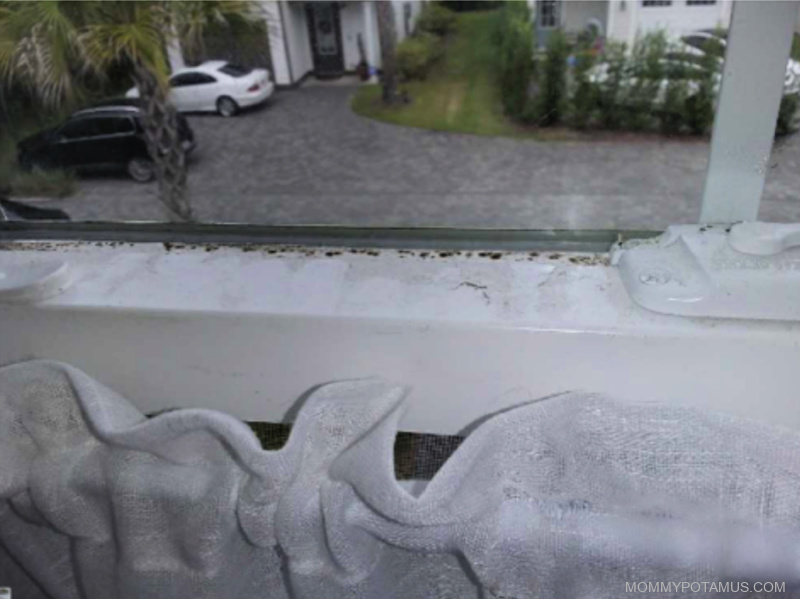
Kitchen
Sink – Kitchen sinks handle a lot of food particles, which mold absolutely loves. Check sponges, the disposal, and in/around the sink for musty odors or visible signs of mold. Also check under the sink for any indications of leaks such as discoloration or visible growth.
Dishwasher – Because they’re moist, warm, and dark, dishwashers can definitely develop mold. If yours has a musty smell or a visible film of any kind, it may indicate mold. Frigidare makes a dishwasher probiotic that I use occasionally to discourage the growth unwanted mold/bacteria.
Refrigerator – If you use the water dispenser on your fridge (hopefully with this fridge filter that removes 232+ contaminants), make sure to clean it and flush the line regularly. You’ll also want to check the line that supplies water for your ice. Make sure there isn’t any standing water in the drip tray. Remove any old food that is in the fridge and wipe down the shelves.
Pantry – Remove old food and check for any signs of moisture or growth.
Countertops, stovetop, and inside cabinets – Check for any signs of moisture or growth.
Windows – As I mentioned above, condensation can sometimes collect near windows and cause growth. When my home was inspected a year after our flood, the team found that the sash lock area was not sealed properly and condensation/mold spores were coming in from the outside and forming a little colony. You can see the photo from their report at the top of this section. We fixed the sealing issue and the minor mold issue was fully resolved.
Walls, ceiling and floor – Check for signs of water damage or growth on walls, the ceiling and the floor area. In addition to visible mold, moist or peeling wallpaper or paint can also indicate that a problem is happening under the surface.
Other places to check – Cutting boards and trash cans.
Tips for keeping your kitchen free of mold
- Monitor and manage humidity levels. See the section above on keeping bathrooms free of mold for more information.
- As I mentioned above, if you use the water dispenser on your fridge (hopefully with this fridge filter that removes 232+ contaminants), make sure to clean it and flush the line regularly.
- Wash your dishes daily
- Keep countertops/floors clean and dry
- Toss old food and wipe down fridge shelves regularly
- Clean window sills and sash lock areas regularly
- Clean the bottom of your trash can regularly
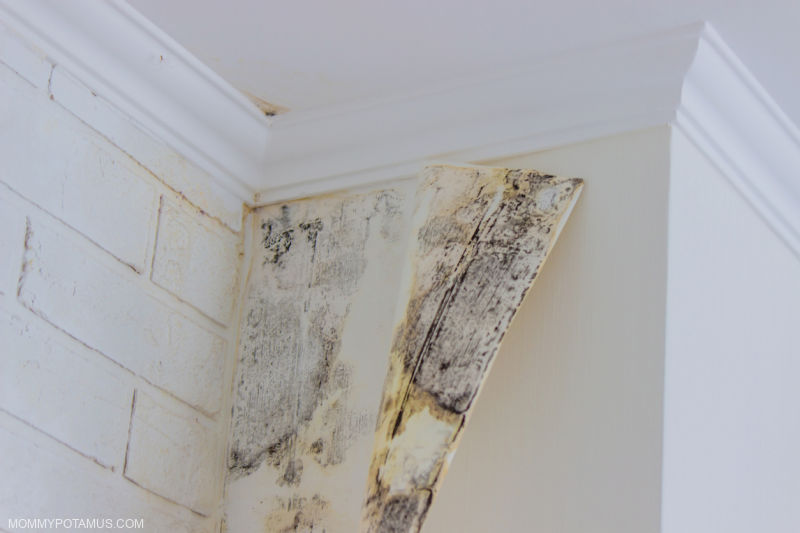
Living Room
Windows – Check all window sills and window frames for signs of condensation or growth.
Fireplace and chimney – Chimneys that are poorly ventilated or in need of maintenance can develop mold issues. The main reasons that moisture can collect in fireplaces/chimneys are a cracked chimney crown, non-waterproof brick and mortar, or a damaged chimney cap. Growth tends to happen slowly and may not be noticeable or visible. However, having your fireplace/chimney regularly inspected by a specialist can identify potential issues and help you figure out what proactive or corrective steps may need to be taken.
Indoor plants – If humidity levels are within the optimal range houseplants are not likely to cause an issue, but if you want to be extra cautious you can give them soil probiotics that encourage the growth of beneficial microbes (vs unwanted ones). Also make sure not to over water.
Walls, ceiling and floor – Check for signs of water damage or growth on walls, the ceiling and the floor area. In addition to visible mold, moist or peeling wallpaper or paint can also indicate that a problem is happening under the surface.
Tips for keeping your living room free of mold
- Monitor and manage humidity levels. See the section above on keeping bathrooms free of mold for more information.
- Have your chimney inspected and cleaned by a professional
- Dust surfaces and vacuum carpets/hard flooring regularly – One of the experts I work with told me that “dust is mold food,” and one of the best things I can do to improve indoor air quality is to dust all surfaces and vacuum floors regularly. Unlike sweeping and regular vacuums which stir the dust up into the air, a true HEPA vacuum uses powerful suction to capture and retain dust particles instead of spreading them. This HEPA vacuum was voted best budget pick by Prevention Magazine.
Bedrooms
Mattress – High humidity levels and/or children’s bedwetting accidents can cause mattresses to grow mold, so take off the sheets and give it a good inspection.
Windows – Check all window sills and window frames for signs of condensation or growth.
Walls, ceiling and floor – Check for signs of water damage or growth on walls, the ceiling and the floor area. In addition to visible mold, moist or peeling wallpaper or paint can also indicate that a problem is happening under the surface.
Tips for keeping bedrooms free of mold
- If you have little ones that occasionally wet the bed, invest in an organic cotton mattress protector with waterproof barrier
- Monitor and manage humidity levels. See the section above on keeping bathrooms free of mold for more information.
- Dust surfaces and vacuum carpets/hard flooring regularly.
- Pay attention to floors and baseboards around kids’ beds and bedside tables. Liquids may have spilled and not been found.
Laundry Room
Washing machine – Washing machines are vulnerable to mold, which can be transferred to clothes and indoor air – often in places we can’t easily see. So, if you’ve ever had a load of clothes come out of the wash smelling funkier than they went in, it may be time to give it a good cleaning. Here’s how.
Dryer – Check the dryer vent and hose for clogs or wet lint. Lint may become trapped against the grill of vent covers and can reduce the ability of a dryer to vent moist air out of the machine.
Windows – Check all window sills and window frames for signs of condensation or growth.
Walls, ceiling and floor – Check for signs of water damage or growth on walls, the ceiling and the floor area. In addition to visible mold, moist or peeling wallpaper or paint can also indicate that a problem is happening under the surface.
Tips for keeping your laundry room free of mold
- Avoid leaving wet clothes in the washer or dryer for long periods.
- Clean your washing machine regularly. The recommended frequency can vary based on how many loads of laundry you do each week, how humid your environment is, and how hard your water is. In general, a top-loading washer should be cleaned between every three to six months, and a front loading machine should be cleaned monthly.
- Make sure the ventilation in your laundry room is working well (Ideally it should vent outside, not into the attic)
- Monitor and manage humidity levels. See the section above on keeping bathrooms free of mold for more information.
- Dust surfaces and vacuum carpets/hard flooring regularly
Attic
The home I live in has a thick layer of spray foam insulation in the attic. The builder added it to make the home more energy efficient, which I appreciate, but it also means the attic couldn’t “breathe” and release moisture. We tried venting the attic which didn’t work, so we ended up having a dedicated dehumidifier installed up there.
Although our situation is pretty uncommon – most attics probably don’t need a dehumidifier – it’s pretty easy to miss issues because we rarely visit this storage area. That’s a problem, because they often contain part of the ventilation system and may impact air quality throughout the home.
With that in mind, here are some things to check for:
Ventilation – Does the attic have a working attic fan or gable vents?
Surfaces – Are there any signs of water damage, dampness or growth on the roof, framing, floor or insulation?
Tips for keeping your attic free of mold
- If moisture is venting from bathrooms or the laundry room into your, consider rerouting the vent outside if possible
- Make sure gutters stay clear
- Quickly address roof leaks
- Monitor and manage humidity levels. See the section above on keeping bathrooms free of mold for more information.
Basement
My home doesn’t have a basement so this section is not based on my recent inspection, but here are some things to check for
Pipes and ducting – Is there any evidence of leaking, moisture, condensation or visible growth?
Foundation – Are there any cracks or indications of leaks (a professional may be needed to answer this question)
Sump pump (if present) – Is there any evidence of leaking, moisture, or condensation?
Windows – Do window sills or window frames have signs of condensation or growth?
Vents – Are there any signs of condensation or growth?
Tips for keeping your basement free of mold
- Monitor and manage humidity levels. See the section on keeping bathrooms free of mold for more information.
- Make sure there is adequate ventilation
- Fix drainage issues and/or structural issues that could allow water to seep in
Garage
Walls, ceiling and floor – Check for signs of water damage or growth on walls, the ceiling and the floor area.
Storage areas – Check behind (or in) any storage boxes that don’t get moved around very often
Additional places to check for mold in your home
Air conditioning and heating ducts – If ductwork develops mold, it can spread spores, MVOCs and mycotoxins throughout the home. Check your HVAC system regularly to make sure it’s draining properly, and replace filters as needed. If you suspect your HVAC system may have mold, you’ll probably need to have a professional inspect it for you.
Exterior doors – Check around the edges of the doors and frames for condensation or growth due to poor sealing or structural issues.
Water heater or furnace – Check for water in the drip pan and/or other signs of moisture or mold
Carpet – Large spills or leaks can cause mold growth in the carpet or padding that you might not be able to see (or smell). The best approach is prevention, so dry any spills or leaks very thoroughly, or hire a professional if needed.
Crawl spaces – I don’t have these so I can’t share personal insights, but here are some things to look for.
Next Steps
If you find a small mold issue on a non-porous surface, you may be able to clean it with a non-toxic botanical product like Benefect Botanical Decon 30 or EC3 Mold Spray. I’ve also used this ozone sanitizing spray bottle to clean non-porous surfaces and it works well, just make sure to wipe away all excess moisture after cleaning.
For fabrics, washing several times with EC3 laundry additive may help. Because I have a genetic mutation that makes me especially reactive to mold toxins, my husband installed this ozone laundry system onto our washing machine for extra peace of mind.
Porous surfaces generally need to be removed. Just like weeds that grow outside, they tend to have deep “roots” that extend deep into the surface, far beyond what you can spray. Just spraying the surface is like cutting off the visible part of a weed, it’s roots are still intact so it can easily grow back.
Important note: Don’t use bleach on mold. It will probably not kill all the growth, but it will make the area very wet since it’s 90+ percent water. and may make the problem worse. Any mold that survives will love the extra water and most likely flourish even more.
If you find a significant mold issue or you are extremely mold sensitive, don’t try to remediate it yourself. Hire a professional that knows how to remove it properly. If you’d like to learn more about choosing a mold specialist, let me know in the comments below.
As I mentioned at the beginning of this article, this checklist is not a replacement for a professional evaluation. Mold growth can be hidden inside walls, ductwork, and other places that are impossible to check visually, so if you suspect an issue it’s best to have a professional come in and do a thorough inspection that includes a visual inspection, swabbing any surfaces that appear to have growth, and conducting an air sample test.
With that said, there are some DIY air quality tests like ERMI and HERTSMI which may be able to tell you more about environment with in your home. If you’d like to learn more about the pros/cons of using them and how to take a sample, let me know in the comments below.
If want to learn more about . .
- Testing homes for mold
- Testing for mold illness in people
- Detox strategies
. . . let me know in the comments below. If there’s enough interest I’ll follow up with more articles.
Sources
- Wall Street Journal (2013) The $500,000 Housecleaning
- Environmental Protection Agency. What Are Molds?
- Centers for Disease Control. Basic Facts about Mold and Dampness
- Joseph Pizzorno, ND and Ann Shippy, MD (2016) Is Mold Toxicity Really a Problem for Our Patients? Part 2—Nonrespiratory Conditions
- Stephanie Kraft et. al. (2021) Mold, Mycotoxins and a Dysregulated Immune System: A Combination of Concern?
- Ardeshir Ziaee et. al. (2018) Identification of saprophytic and allergenic fungi in indoor and outdoor environments
- National Cancer Institute. Aflatoxins
- Rhys Brown et. al. (2021) Fungal Toxins and Host Immune Responses
- Mayo Clinic. Aspergillosis
- Devanshi Mehta et. al. (2021) First Reported Case of Invasive Cutaneous Penicillium cluniae Infection in a Patient With Acute Myelogenous Leukemia: A Case Report and Literature Review
- Noreen N Khan and Bobby L Wilson (2003) An environmental assessment of mold concentrations and potential mycotoxin exposures in the greater Southeast Texas area
- Mohannad Abdullah Alwatban et. al. (2014) Mycotoxin Production in Cladosporium Species Influenced by Temperature Regimes
- Mariusz Dyląg et. al. (2022) Update on Stachybotrys chartarum—Black Mold Perceived as Toxigenic and Potentially Pathogenic to Humans
- Ian Greaves (2010) Biological Agents
- Lynne Haber et. al. (2015) Review of the Health Risks of Mold
- Yong Zhang et. al. (2020) The genome of opportunistic fungal pathogen Fusarium oxysporum carries a unique set of lineage-specific chromosomes
- Environmental Protection Agency: Why and Where Mold Grows
Continue reading 35+ Places to Check for Mold In Your Home...

